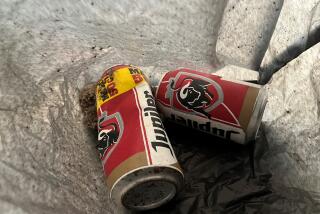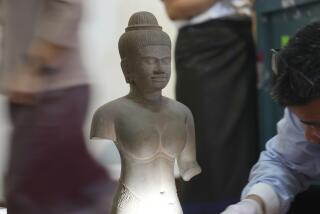Soviets Will Return Art to Germany
- Share via
WASHINGTON — More than 360 master drawings and watercolors and two small paintings by Durer and Goya, presumed lost forever from a German museum during World War II, are about to be returned to the museum by a former Soviet army officer who carried them to Moscow in a suitcase 45 years ago for safekeeping.
According to Siegfried Salzmann, director of the Bremen Kunsthalle in West Germany, the works were rescued from mold and from pilfering Germans and Soviet soldiers at the end of the war by Viktor Baldin. The Soviet officer, who is now 72 and a retired architect, restorer and museum director, came upon them in the ruins of a castle 90 miles north of Berlin, where museum officials had placed them for protection against Allied air raids on the port of Bremen.
The hoard constitutes one of the largest and most valuable collections of art to be returned to any German museum since the Allies redistributed thousands of works found hidden in German salt mines after World War II. At the hoard’s “heart,” said Salzmann, are 28 drawings and watercolors by 16th-Century German artist Albrecht Durer.
Included are 362 old master and modern drawings and watercolors by Raphael, Goya, Rembrandt, Rubens, Delacroix, Manet, Monet and Degas and what is said to be Van Gogh’s only known drawing for his famous painting “Starry Night.”
According to dealer Eugene V. Thaw, a specialist in old master drawings, such a collection would “have to be worth several hundreds of millions of dollars. Any Durer drawing today is worth $1 million plus. A good one is worth several million.”
Diane Russell, the National Gallery of Art’s curator of old master prints, said: “If some Durers have turned up, that would be incredible.”
“It’s fantastic,” Salzmann said. “There has been nothing like it.”
Their value, he said, is incalculable. “It’s impossible to say, given prices today.”
But money is not the issue, he said; Baldin is asking nothing for the return of the works. They have been stored in the basement of the architecture museum in Moscow, of which Baldin was director for a time, and were never shown. They are being returned now through the efforts of Baldin, who Salzmann said had the support of Soviet President Mikhail S. Gorbachev.
“We are currently receiving photographs of the items from our embassy in Moscow,” said Salzmann, who said this situation is in no way comparable to the Quedlinburg church treasures allegedly stolen from their hiding place by a U.S. Army officer, and recently discovered in the vaults of two Texas banks.
“The Quedlinburg items were stolen. This is quite a different thing because (Baldin) is a very honest man and he took nothing for himself,” Salzmann said. “When everybody was taking things away and destroying them, he tried to prevent it.”
Salzmann said he had been introduced to Baldin 18 months ago by a woman from Dusseldorf who said she had a Russian friend with an interesting story.
“So I contacted him, Viktor Baldin, who had been a young lieutenant who had studied architecture. He came to Bremen and we talked. Then I went to Moscow to pick up all the documents,” Salzmann said.
In the late 1960s, after Baldin became the director of the museum of architecture, Salzmann said, “he tried to get help from his government to get these things back, but there was no answer from (Leonid I.) Brezhnev. But he asked Gorbachev and it is working.”
The works were among 4,000 works of art that had been taken to the castle for safekeeping.
The paintings are small--”the only things he could put in his bag,” Salzmann said. The Durer is a head of Christ dated 1512, and the Goya is a sketch for a painting of a Spanish duke.
More to Read
The biggest entertainment stories
Get our big stories about Hollywood, film, television, music, arts, culture and more right in your inbox as soon as they publish.
You may occasionally receive promotional content from the Los Angeles Times.










